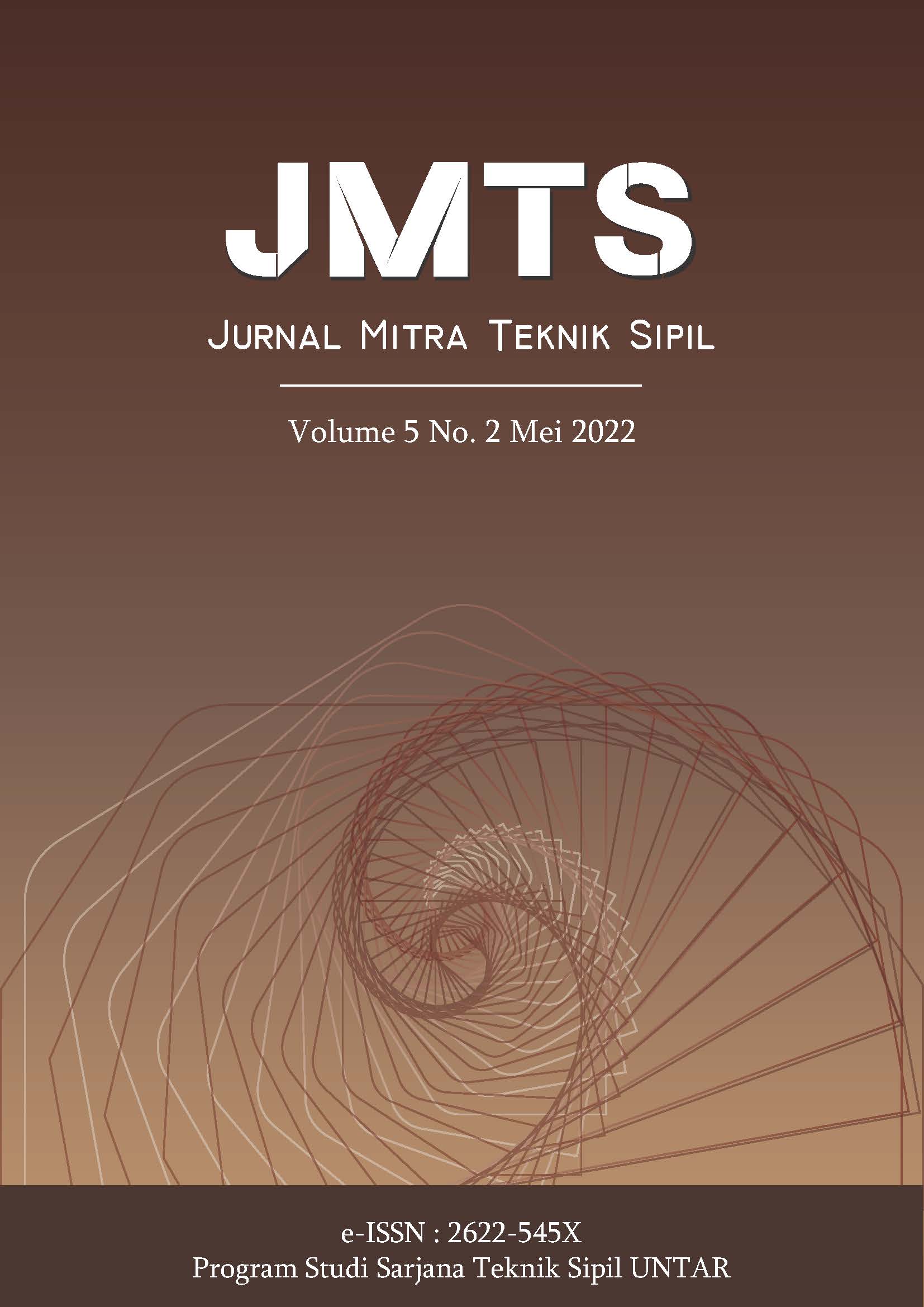Analisis Pengaruh Bentuk Bukaan Pada Pelat Lentur Dengan Metode Elemen Hingga
Main Article Content
Abstract
Openings in the slab are generally unavoidable. Openings need to be provided to meet the needs of services such as water pipes, electrical wiring, and air vents. The area around the opening will experience an increase in deflection and stress. In this thesis, the plate will be analyzed with variations in the shape of the opening and boundary conditions. The shape of slab is square and receives a transverse uniform load. The shapes of the openings are square, rectangle, and circle. The area of the openings is kept the same and flexed at the center of the plate with different boundary conditions i.e. simple support, fixed on 4 sides, fixed on 3 sides, fixed on 2 opposite sides, and fixed on 2 adjacent sides. Slab analysis with openings was carried out using the finite element method and the help of the MIDAS FEA software. The results of the analysis showed that among the three shapes of openings, area around rectangular openings tend to produce the highest increases in displacement and stress viz. 2.6 times and 4.7 times. Meanwhile, area around the circular opening experienced the lowest increase in deflection and stress viz. 1.3 times and 1.1 times. The boundary conditions that cause the highest increase in deflection and stress are simple supports.
Bukaan pada pelat umumnya tidak dapat dihindarkan. Bukaan perlu dibuat untuk memenuhi kebutuhan pelayanan seperti pipa air, kabel listrik, dan ventilasi udara. Daerah pada sekeliling bukaan akan mengalami peningkatan lendutan dan tegangan. Pada skripsi ini, akan dianilisis pelat dengan variasi bentuk bukaan dan kondisi batas. Pelat yang dianalisis berbentuk bujur sangkar dan menerima beban merata secara transversal. Bentuk bukaan yang dianalisis adalah bujur sangkar, persegi panjang, dan lingkaran. Luas ketiga bentuk bukaan dipertahankan tetap sama dan diltekkan pada pusat pelat dengan kondisi batas yang berbeda-beda yaitu tumpuan sederhana, jepit di 4 sisi, jepit di 3 sisi, jepit di 2 sisi berseberangan, dan jepit di 2 sisi bersebelahan. Analisis pelat dengan bukaan dilakukan menggunakan metode elemen hingga dan bantuan software MIDAS FEA. Hasil analisis menunjukkan diantara ketiga bentuk bukaan, bukaan berbentuk persegi panjang cenderung menghasilkan peningkatan lendutan dan tegangan yang paling tinggi yaitu sebesar 2.6 kali lipat dan 4.7 kali lipat. Sementara bukaan berbentuk lingkaran mengalami peningkatan lendutan dan tegangan yang paling rendah yaitu 1.3 kali lipat dan 1.1 kali lipat. Adapun kondisi batas yang menyebabkan terjadinya peningkatan lendutan dan tegangan yang yang paling tinggi adalah tumpuan sederhana.
Article Details
References
Aradhna A. Ganvir & Prof. V.S. Singhade. (2016). Comparative Study of Reinforced Concrete Flat Slabs with and without Openings using Finite Element Analysis. International Journal for Innovative Research in Science & Technology, 3(2), 245-252.
Ashish S. Bora, Darshan G. Gaidhankar & Mrudula S. Kulkarni. (2019). Analysis of Flat Slab with and Without Opening. International Journal of Scientific & Technology Research, 8(9), 1455-1459.
B.C. Punmia, Ashok Kr. Jain, Arun Kr. Jain. (2007). Limit State Design of Reinforced Concrete. Laxmi Publications: New Delhi.
Daryl L. Logan. (2007). A First Course in the Finite Element Method, Fourth Edition. Nelson: United Kingdom
Dina Hassan, Ata El-Karim Shoeib, Magdy M. Genidy & Sherif F.M. Abd Elnaby. (2017). The Effect of Introducing Openings of Different Shapes on the Behavior of Two Way Solid Loaded Slabs. International Conference on Advances in Structural and Geotechnical Engineering ICASGE’17.
H. Ali Asroni. (2010). Balok dan Pelat Bertulang. Graha Ilmu: Yogyakarta.
Hendy Wijaya. (2013). Analisis Struktur Pelat Berlubang Dengan Metode Elemen Hingga. Skripsi. Universitas Tarumanagara.
I. Katili. (2004). Metode Elemen Hingga untuk Pelat Lentur. Universitas Indonesia: Jakarta.
James B. Deaton. (2005). A Finite Element Approach to Reinforced Concrete Slab Design. Thesis. Georgia Institute of Technology
James K. Wight. (2020). Reinforced Concrete Mechanics and Design.
Pearson: New Jearsey.
M. W. Bari, M. M. Rahman, M. M. Y. Ali & M. R. Awall. 2004. Finite Element Analysis of Slab and a Comparative Study with Others Analytical Solution. 7th ICCT, 265-272.
O Brooker. (2006). How to Design Reinforced Concrete Slabs Using Finite Element Analysis. The Concrete Center: Surrey.
Roshini T. Mohan & Sansakaranarayaan K.M. (2016). Analysis of Twoway Slabs with and Without Opening for Different Boundary Conditions. International Journal of Scientific and Research Publications, 6(7), 151156.
S. Durgadevagi & N.A. Jabez. (2016). A Comparative Analysis of Slab with Different Shape of Cutout for Various End Condition Using ANSYS. Journal of Chemical and Pharmaceutical Research, 8(12), 180-184.
S. Timoshenko. (1951). Theory of Elasticity. McGraw: New York.
SNI 2847:2019. (2019). Persyaratan Beton Struktural. Jakarta: Badan Standarisai Nasional.
Sunil Kumar M.S. & B.S. Suresh Chandra. (2014). Experimental Study on Self Compacting RC Slab with and without Opening. International Journal of Engineering Research & Technology (IJERT), 2(8), 202-206.



